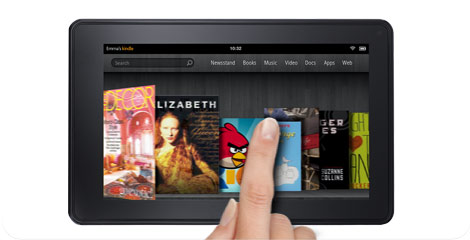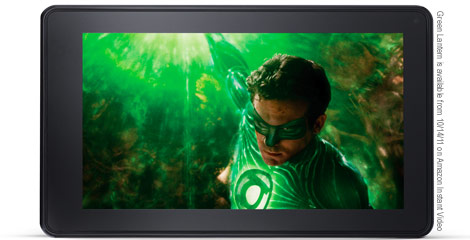
by Larry Magid
Amazon’s new Kindle Fire tablet isn’t an iPad killer, but it could be an iPad wounder. Yes, there are plenty of things I prefer about the $499 iPad 2 over the $199 Kindle Fire but — aside from being $300 cheaper — the Kindle’s smaller form factor has its advantages.
The Kindle Fire, as you might expect, is an excellent book reader. It’s considerably smaller and almost seven ounces lighter than an iPad 2 (14.6 vs. 21.3 ounces) which is actually an advantage while reading. And its back-lit screen means it can work well in dark places, like a bedroom where one partner wants to read while the other one is sleeping.

Music and video
The Kindle is also good for listening to music, as long as you have your music stored on Amazon’s cloud service. Amazon gives everyone five gigabytes of free storage which isn’t nearly as much as you get from Google’s free music service but $20 a year gives you unlimited music storage plus 20 gigabytes for other content — all easily accessible form the Kindle Fire.
If you subscribe to the $79 Amazon Prime service (that also includes free two-day shipping on Amazon orders) you get access to thousands of free videos. The library is a lot smaller than what’s on Netflix but it’s hard to argue about the price. You can also rent or purchase newer movies and TV shows from Amazon that you can view on the Kindle Fire and other devices, including PCs and Macs.
To Amazon’s credit, they loaded the device with a Netflix app which enables Netflix subscribers to immediately access movies and TV shows. Watching a video on the seven inch screen is fine for one person and may even be OK for two people who don’t mind sitting or lying very close to each other.
Uninspiring physical design, not-so-great battery life & missing camera and mic
In terms of its physical design, the Kindle Fire is uninspiring. It’s boxy and downright boring, especialy when compared to an iPad 2 that looks great and feels good in your hands.
The Kindle Fire also lacks a physical home button (or any other buttons) and the on-off switch is incredibly small, though you will get used to it quickly. I hate that there are no dedicated volume controls. To adjust the volume you have to press a tiny settings icon and then slide the volume control.
There is no way to expand the paltry 8 gigabyte memory nor is there Bluetooth, a USB data connector or a 3G cellular option. It’s all about WiFi. If you want connectivity on the go, you can purchase a WiFi hotspot device like the MiFi or see if your cell phone has a WiFi tethering option (in both cases you’ll pay a monthly fee to your cell carrier).
The device’s small stereo speakers are pretty good and, for most content, loud enough, though with one Netflix movie I watched, I couldn’t get it loud enough. There is a standard headphone jack but the device doesn’t ship with a headphone.
Amazon claims “up to 8 hours of continuous reading or 7.5 hours of video playback, with wireless off,” which is pretty bad, especially since you will need wireless on if you’re streaming video content. Apple claims up to 10 hours with Wi-Fi on.
Unlike the iPad 2 or even the newest iPod Touch, the Kindle Fire also lacks a camera, a GPS and a microphone.
Size matters but small can be big
The fact that the Kindle is smaller than an iPad cuts both ways. On the down side, the iPad’s additional screen real estate means a bigger screen for video and a magazine-size page for reading. But the smaller Kindle is easier to carry around and actually (but barely) fits into my pants front pockets — at least the pants that I’m wearing today.
In some ways, the Kindle Fire is a cross between an iPod Touch and an iPad but priced the same as an iPod Touch. The iPod Touch has the advantage of running virtually all of the apps for the iPhone but the Kindle Fire’s larger screen gives it a more tablet-like feel which is a big advantage over the Touch.
Priced and sized for kids & maybe even schools
I have a feeling that a lot of parents will consider getting a Kindle Fire for their kids. $199 may not be cheap enough for a lot of parents, but there are plenty who have spent that much or more on an iPod Touch for their kids. Unlike the iPod Touch, the Kindle Fire is a serious book reader and a decent media player which could come in very handy if schools ever get around to issuing e-books instead of those heavy and expensive text-books. Still, I don’t want to see Amazon dominating the school text-book market so I’d prefer school books be published in a format that can be used on any device, including the Kindle Fire.
What it might inspire
By pricing the Kindle Fire at $199, Amazon has set a price threshold that will have an an impact on the entire industry. While I don’t expect Apple to be lowering iPad prices any time soon, it is certainly paying attention and will consider Amazon’s impact when it prices its iPad 3. Other companies, without the market domination of Apple, will have to take this price extremely seriously Frankly, I’ve never thought it worthwhile to spend $500 or more on a tablet other an an iPad and now I’m not sure there’s much of a reason to spend more than $200.
But the the problem — for anyone but Apple, Amazon and Google and perhaps the mobile carriers — is that to make any money at this price point, there needs to be an ongoing revenue source. It could be book, music and video sales or even the sale of physical goods as Amazon no doubt hopes the Kindle Fire will stimulate. Or it could be the old-fashioned cellular subsidy model that works so well for phones in the U.S.
Whatever business models emerge, Amazon truly has lit a “fire” that’s sure to heat up the competition.
Will dent iPad market
Given the price difference, I can envision a lot of budget minded shoppers opting for the Kindle Fire over the iPad. It won’t satisfy everyone but enough people will be happy enough with the Kindle Fire to make it a serious competitor.
Be the first to comment